Facing ( Sheathing) - a layer of natural or artificial building material (wood, stone, tile, etc.), giving a special appearance, both to the facades of buildings, and to the internal surfaces of the structure, and also able to serve as protection against various negative influences. Facing material is made for interior and exterior cladding works.
Facing works - type of finishing works, during which the face surfaces of structures are covered with facing materials. Facing works, as well as facing material, are divided into:
- Outdoor (facing of facades)
- Internal (facing the surfaces of internal premises: walls, partitions, floors, etc.).
As facing materials for facade of buildings can act:
- natural stone;
- fake diamond;
- facing bricks;
- facing panels;
- thermopanels;
- tile for brick;
- decorative plasters;
- siding;
- keramosiding;
- profiled wall sheet.
For facing surfaces of internal premises often apply:
- tile , made of artificial materials, such as ceramics, glass, plastic, etc .;
- flagstone , plates of natural natural stone of various shapes and different lengths;
- lining made of plastic, wood and other materials;
- roll facing materials .
According to their purpose, facing can be:
- Protective coverings - type of lining, designed to protect the surface from such harmful environmental influences as severe climatic conditions, as well as from mechanical damage, exposure to fire and various chemicals. An example is a decorative paper-laminated plastic.
- Acoustic cladding - Facings that can absorb sound. For example, special acoustic sandwich-profiles.
- Sanitary and hygienic facings - cladding, allowing to maintain the cleanliness of the premises, and, if necessary, quickly disinfect them. For example, smooth ceramic tiles.
- Decorative cladding - designed to create comfort and coziness in the room, as well as give it individuality, and generally improve the appearance of the room. For example, a relief seamless tile.
The next necessary factor is the correct choice of lining material. Why is it so important.
At first , wrong choice of the facing material can cause damage to the room, and perhaps life or health of a person. If, for example, in the bathroom lay the floor with a tile, which, if water hits it, the life or health of the person will be in danger. Or, if the walls are finished with ordinary (not moisture-resistant) gypsum board, and paper (moisture-susceptible) wallpaper is pasted on, then as a result of constant exposure to steam the wallpaper, and the wall itself, will soon become unusable.
Secondly , incorrect selection of the lining material can make it difficult to maintain the room or violate any norms. For example, the use of plastic lining in the kitchen on the walls in the area of the "work area", or gas and electrical appliances, leads to a violation of sanitary and hygienic standards and to violation of fire safety.
Thirdly , any lining material is resistant to operation under certain conditions and loads.
Fourthly , properly selected facing material will last much longer.
Facing the facades of buildings plays not only the role of decor, but also performs several applied functions: it makes the house warmer, improves sound insulation, and also protects the walls from the environment, thereby increasing the life of the building. The market presents facing materials with different strength, thermal conductivity and vapor permeability.
- artificial or natural stone,
- clinker tiles (facing bricks),
- porcelain tiles,
- expanded polystyrene,
- siding,
- sandwich panels,
A rock
Stone is considered to be the most durable building material, therefore it is most often used for laying foundations of loaded structures. At the same time, many types of stone are very beautiful, which provided them with wide application in decoration. Most profitable is polished or varnished stone. When finishing the facades of houses use natural stone, as well as its artificial counterparts. The buildings covered with this material look very stylish and noble.
Advantages of stone:
- quick installation,
- durability,
- an excellent thermoregulation, ensuring the preservation of heat in winter and cool in the summer,
- the uniqueness of the pattern of stone surfaces,
- environmental friendliness.
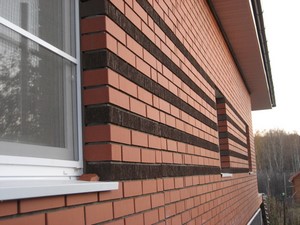
Most of the shortcomings of the stone are due to its large weight. This material is difficult to transport and process, and the foundation of the stone-clad building receives additional load, which must be taken into account at the design stage of the house. The nature of the stone causes its susceptibility to overgrowing with moss, which will have to be periodically cleaned.
Clinker tiles
Clinker tiles - this is a facing material, stylized as a brick. Quite often clinker tiles are called facade bricks. This finishing material is used for the lining of the cap, the whole or its individual parts. The clinker is available in various colors. Also there are glazed tiles.
Advantages of clinker:
- wear resistance,
- simplicity of laying,
- strength,
- low water absorption,
- high thermal conductivity.
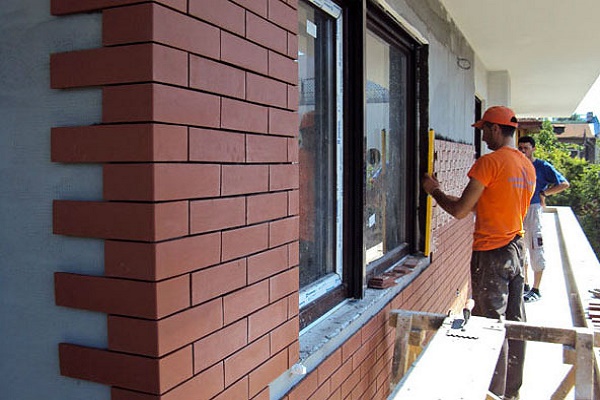
The disadvantages of clinker can be attributed to mandatory compliance with certain conditions when stacking. Tiles should not be placed in rainy, cold or hot weather. Installation of the clinker is performed at an air temperature of + 5ºC to + 25ºC, and the surface to be treated must be perfectly flat. In addition, the corner parts of the clinker may differ in color, which should be taken into account when creating a pattern on the facade of the house.
Porcelain tiles
Ceramic granite is a stylized finishing material. The design of ceramic granite slabs allows creating real pictures on the facade of the house, however this decoration is quite expensive.
Advantages of porcelain tiles:
- durability,
- high strength, providing the walls of the house with reliable protection against adverse environmental factors,
- excellent thermoregulation, which allows to significantly reduce the cost of heating the building,
- a variety of colors and sizes of slabs.
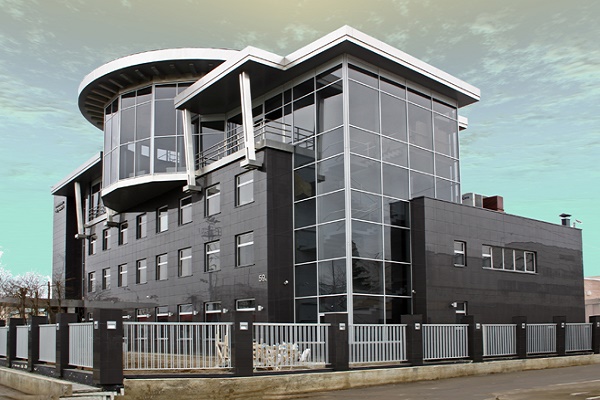
Big weight is considered the main drawback of ceramic granite, because of what this type of finish can not be used at all facilities.
Styrofoam
Expanded polystyrene is a porous finishing material made from polymeric styrene. Visually, polystyrene resembles a conventional foam, but is much stronger and more durable than the latter. Expanded polystyrene panels are very light, but at the same time they keep the heat perfectly, therefore this kind of decoration is primarily used for high-quality insulation of the facades of houses.
Advantages of expanded polystyrene:
- cheapness,
- not toxicity,
- simplicity of processing and installation,
- high heat and noise insulation.
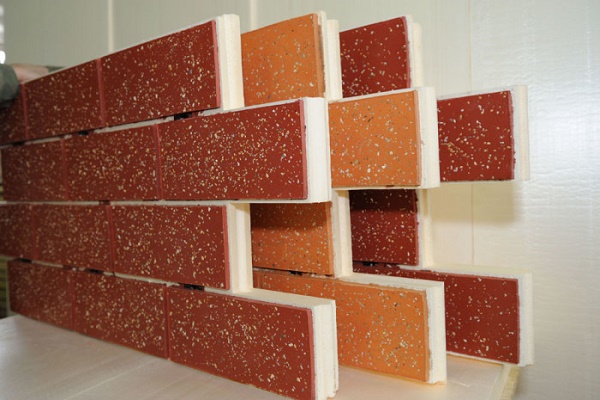
The disadvantage of expanded polystyrene is its high water absorption, so this material must be covered by other types of finishing, such as plaster or siding.
Siding
The siding installation is a very popular method of ennobling the facade of the house with minimal investment. A variety of colors and textures siding allows you to realize almost any design project.
There are several types of siding, but for facade cladding, vinyl panels are most often used, which look like a finishing board, but considerably surpasses its durability and durability, because unlike a tree, siding does not rot and practically does not burn out in the sun.
Advantages of vinyl siding:
- flexibility, allowing to cover buildings of various architecture,
- ease of cutting and assembly,
- low cost,
- excellent tolerance of temperature changes and precipitation.

The disadvantages of vinyl siding are low resistance to mechanical damage, as well as susceptibility to accumulation of dirt.
Sandwich panels
Sandwich panels are three-layer blocks, consisting of two metal sheets, between which is a magnesia plate. The outer side of the panel can be smooth, corrugated or decorated, which allows to give the facade a unique appearance. Despite the richness of forms and textures, the main purpose of wall sandwiches is still the insulation of houses.
Advantages of sandwich panels:
- quick installation,
- durability,
- low water absorption,
- fireproofness,
- excellent thermal insulation,
- no need for additional finishing,
- environmental friendliness.
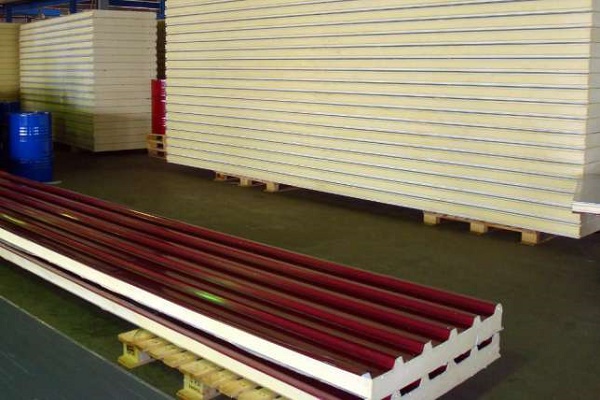
The main disadvantage of wall sandwich panels is their low resistance to damage. Also, when installing this type of facade finish, it is necessary to provide for the presence of ventilation ducts under the panels, since the tightness of sandwiches can cause accumulation of moisture formed as a result of the greenhouse effect, which can lead to the appearance of fungus on the walls of the house.
Plaster
The popularity of decorative plaster is explained by its low cost and ease of application. This finish improves the aesthetics and increases the thermal insulation properties of the walls. In addition, the use of various finishing techniques allows you to vary the structure of the rendered plaster and obtain textured patterns. That is why the facade plaster is sometimes called textured.
Advantages of plaster:
- high adhesion to any substrate,
- low susceptibility to mechanical damage,
- simplicity of storage and application,
- resistance to atmospheric phenomena,
- an extensive color palette,
- price accessibility,
- environmental friendliness.
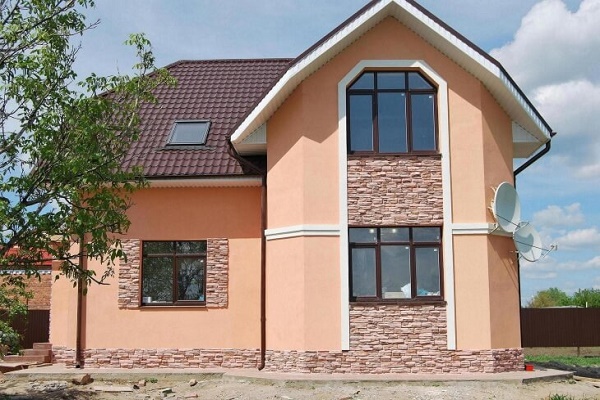
Disadvantage: over time, in the texture cavities of the plaster, hard-to-remove dirt accumulates.
When choosing a cladding for a house, it is worth considering not only the aesthetics of a particular material, but also a number of other important factors, such as the complexity of the installation, structural strength, heat exchange and moisture absorption, and the possibility of replacing the damaged finish without dismantling the entire structure.
→ Facing works
Appointment and types of facing and plastering works
Facing works refer to finishing works and consist of a number of operations to strengthen finishing piece materials on the surfaces of structural elements of buildings and structures. There are external (mainly facades of buildings) and internal (walls, partitions, floors and other elements of buildings inside buildings) facing.
Facades of buildings are faced with natural or artificial stone, artificial slabs and various architectural details, ceramics, facing bricks and other materials. This cladding is performed, as a rule, simultaneously with the laying of the walls.
Interior lining is usually performed on previously erected walls, partitions or other elements inside buildings. For interior lining, mainly use artificial materials, which include tiles of small and medium sizes - ceramic, concrete-mosaic, glass, plastic (polystyrene, polyvinylchloride, etc.), large-sized - asbestos-cement sheets, fibreboard with a smooth or off-tanned surface , covered with synthetic enamels, sheets of laminated plastic and, finally, roll facing materials.
According to the purpose of the cladding, there are protective, acoustic, sanitary and hygienic and decorative. Protective linings protect the surface from harmful effects of the environment (for example, from wetting, the action of high and low temperatures, the direct action of fire, mechanical damage, the action of chemicals (for example, acids, alkalis, oils) .The acoustic liners absorb sound, sanitary and hygienic contribute The maintenance of the sanitary norms required for the operation of the premises .The decorative lining improves the appearance of the lining surfaces.
In accordance with the purpose of the cladding, the facing material is selected. For example, in rooms with intensive movement and subject to moisture (in bathrooms, in the entrance and stairwells, in the wash rooms), ceramic tiles, as well as slabs and stones with low water absorption, are used for flooring.
For internal lining of walls, partitions, ceramic (burnt clay products), glazed, glass tiles, asbestos cement sheets, fibreboard, enameled, decorative paper laminated plastic, polystyrene tiles are used.
Ceramic glazed tiles with a smooth surface are used mainly for cladding surfaces that must meet the increased sanitary and hygienic requirements, and also be resistant to operation in conditions of high humidity. There are ordinary (flat) tiles, shaped (cornice, corner, plinth, tiles-bands (Fig. XIII.1), as well as ceramic products - built-in parts (for example, soap dishes, brackets, hooks, ventilation grilles, shelves, paper and towel holders), which are combined with conventional facing tiles.The sizes of the bases of such built-in parts are equal or multiples of the size of ordinary facing tiles.
Glazed tiles of various shapes with a relief surface are also used to produce seamless lining. Such tiles, thanks to the protruding board, cover the joints between the plates at half of their perimeter, and the lined surface receives a decorative finish without visible seams.
Glass enamel facing tiles (size 150X150 mm and thickness 4.5-5 mm), which have high chemical resistance, are used to protect building structures from acids, alkalis, oils, mercury vapors and other harmful substances.
Facings of ceramic, glass and other small tiles are very labor-intensive, so in recent years, the internal walls are increasingly faced with large-sized slabs (wood-fiber and asbestos cement), the front surface of which is covered with persistent colored enamels. In rooms with high humidity (for example, in bathrooms, baths, laundries), only asbestos-resistant sheets resistant to moisture may be used. For lining the walls of sanitary units of living quarters, laboratories and various industrial premises where the humidity is low, wood-fiber plates covered with enamel can be used.
Decorative paper-laminated plastic (GOST 9590-61) is used for interior decoration of shops, buffets, office and other premises. It has valuable qualities: water-resistant, does not burn, does not separate, is very resistant to the action of weak acids and alkalis, mineral oils, alcohol and gasoline.
Shower stalls, sanitary units, shops, warehouses, refrigerating chambers, etc., are lined with polystyrene tiles. They have a number of advantages in comparison with ceramic glazed tiles: it is much lighter (mass 1 m2 of polystyrene tiles not more than 2 kg and 1 m2 of glazed tiles 12 kg), cheaper, more diverse in color, easy to be machined (they can be drilled with metal drills, cut with carpenter's saw with fine teeth, planed and polished). The surface covered with polystyrene tiles has a water, acid and alkali resistance, vapor and gas impermeability and dielectricity.
Thanks to all these qualities, polystyrene tiles have become indispensable for facing internal walls and ceilings in production premises for special purposes.
Plasters are ordinary and decorative. Conventional plasters are made of calcareous, calc-gypsum, cement-lime and other solutions. Normal plasters can be covered with paint compositions. In decorative plasters, as a rule, the top layer is painted to the full thickness, which is achieved by introducing pigments into the solution. Decorative colored plasters are mainly used on facades.
Normal plaster is simple, improved and high-quality. Simple plaster is used in non-capital buildings, in rural buildings, temporary buildings, basements, storage and other non-residential premises where thorough surface treatment is not required. This plaster is also called plaster "under the falcon". The average thickness of it should not exceed 18 mm.
Improved plaster is used in residential, school, hospital and other mass-scale buildings, as well as in industrial buildings and in auxiliary rooms of high class buildings. This kind of plaster is also called plaster "under the rule". The average thickness of the improved plaster should not exceed 2 cm.
High-quality plaster is performed in palaces, museums, theaters, hotels, high-rise residential buildings - wherever the requirements are raised for decoration. To ensure the high quality of the plaster it is carried out by lighthouses, that's why it is called "lighthouse" plaster. The average thickness of high-quality plaster should not exceed 25 mm.
Plasters that give the final architectural design of the surface are called decorative. They are made of dry plaster mixes factory-made (these mixtures are called ter-raytovymi) or from colored solutions prepared on site. Terrazitic mixtures and colored solutions consist of astringent materials, pigments and decorative aggregates.
Depending on the type of binder used, decorative plasters are divided into: colored calc-sand; terrazite lime-cement and stone, which are cement-lime, imitating limestone, dolomite, marble, and cement, imitating the facing of granite.
Colored lime and lime-cement plasters are used for finishing facades with brick walls and with walls of piece-shaped porous stones: cinder, ceramic, shell and tuff. They are not allowed for finishing socles, fences, bases of columns and pilasters, profile parts, drafts with large removal and walls subject to increased moisture. Lime plasters should not be applied to a concrete surface and a metal mesh.
Cement-lime plasters are used for finishing heavily dissected brick surfaces with sharply protruding rustles, frequent-girdles, and small pilasters.
The surfaces of each type of ordinary (monolithic) plaster differ from each other in the thoroughness of their processing. Regardless of the quality division, the plaster must have a strong adhesion to the surface of the structures and do not exfoliate from it.
Plaster is formed as a result of layered application of the plaster solution on the surface. Usually the average thickness of the plaster nameta is between 18-20-25 mm (depending on the type). Create a thinner layer of plaster on concrete surfaces. On wooden and stone surfaces, this will lead to translucence of drivings and stitches of masonry, rupture of plaster during warping of dranits. Thick layers of the solution applied in one step is not recommended, since they fall off or drain off the surface. When drying, shrinkage cracks form on them. Therefore, the plaster coating consists of three separate layers applied to the surface.
The first layer of the plaster namet is called the edge of the plaster. When applying the mortar by hand, this layer is made 3-5 mm thick. With a mechanical method, the thickness of the layer should be no more than 9 mm on wooden surfaces, and on stone, concrete and brick - no more than 5 mm. For a spray, prepare a liquid solution containing up to 60% water. When testing the density of the solution with a standard cone, its sediment should be equal to: when applying the solution manually - 12 cm and mechanically - 9 cm. The plaster will hold firmly only when the spray covers all the irregularities and firmly connects to the surface, which in turn depends on the correct choice of the density of the solution and the degree of surface roughness.
The second layer of plaster namet is called a primer. The thickness of the layer should not exceed 9 mm. At thick nametah put some layers of a ground. For the soil prepare a thick, dough-like solution. The water content of the solution is brought to 35% of the volume of the binder, while for the spray it is necessary to have a high water content. The density of the solution according to the standard cone should be 7-8 cm. The soil level the surface and form the main layer and the required thickness of the plaster.
The third layer of plaster is called a cover. The thickness of the covering is 2 mm. The mobility of the solution according to the standard cone should be 7-8 cm, and with the addition of gypsum to the solution, 9-12 cm. But add the gypsum to the coating solution, as during the grouting the solution is rejuvenated. In the coating solution, a fine aggregate is used, sifted through a sieve with apertures of 1.5X1.5 mm. Cover the ground with a covering. The resulting thin layer is easily rubbed and the surface is smooth.
When performing simple plaster, the covering layer is not applied. In this case, the surface of the last layer of soil is wiped. Improved and high-quality plaster is done by applying one layer of spray, one or more layers of soil and a cover layer.
The facade is the face of the house and the first thing that strikes visitors and visitors. The higher the quality of the exterior walls, the more chances to achieve a cozy atmosphere on the site, make your home unique with improved performance.
The facade material of high quality allows not only to transform the appearance of the house, but also to improve its following properties:
- thermal insulation;
- soundproofing;
- resistance of walls to temperature changes.
Please note that the choice of facade materials for cladding should be based on an analysis of atmospheric conditions and its properties.
Consider the duration of operation, wall surface requirements, cost and visual appeal. Below, we consider the main types of materials for facing the outer walls of houses.
Facing the facade with siding: features
The material is not so popular, despite many years of use on the territory of the country. Speaking of the siding, we first of all mean vinyl panels with different widths from 10 to 50 cm. The advantage of the panels is the variety of the texture pattern, in addition, they do not need subsequent staining.
PVC is the main material for making siding. It perfectly withstands testing by aggressive atmospheric environment, preserving the main characteristics, does not require maintenance, it is easy to install.
Compliance with the basic rules for the use of the material will extend its service life to 50 years. The disadvantage of siding panels is the instability to mechanical damage and high temperatures.
Facing brick facade: options and nuances
 Decorative brick for facing the walls is represented by a wide range with a variety of shapes, colors and textures. This is partly justified by its popularity as a facing material. Of particular interest recently are bricks with rounded corners, suitable for the design of openings, arches, decorative walls.
Decorative brick for facing the walls is represented by a wide range with a variety of shapes, colors and textures. This is partly justified by its popularity as a facing material. Of particular interest recently are bricks with rounded corners, suitable for the design of openings, arches, decorative walls.
There are several types of decorative bricks for decoration of facades:
- ceramic;
- clinker;
- hyperpressed;
- silicate.
Despite the obvious advantages of facing bricks, mention should also be made of shortcomings, among which:
How much the advantages outweigh the disadvantages you decide. It remains only to note that the finish facing bricks among other options for facing is not the most expensive, while it looks impressive and solid, saving a presentable appearance throughout the life of the product.
Facing the facade with wooden lining "block house"
By "block house" is understood a material from a natural tree visually reminiscent of a round log. The house with such decoration gives the impression of a structure made of a wooden high-quality log house. Panels for facing are made of solid wood with a perfectly flat surface.
Special technology of material processing allows to avoid cracking of panels and other variants of their damage during operation. Installing wooden panels quickly and simply, fastenings are performed on a pre-prepared crate.
The houses, lined with wood, look elegant and respectable, they keep the heat well, they are pleased with the optimal microclimate in the premises.
Decorating with natural stone: what you need to know
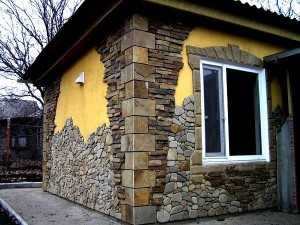 Undoubtedly, natural stone has no analogues among artificial building materials, completely corresponding to it in properties and characteristics. This is the most functional, durable, presented in a wide variety of colors and textures material that can and should be used for finishing the facades with sufficient financial capacity.
Undoubtedly, natural stone has no analogues among artificial building materials, completely corresponding to it in properties and characteristics. This is the most functional, durable, presented in a wide variety of colors and textures material that can and should be used for finishing the facades with sufficient financial capacity.
Advantages of natural stone for finishing the outer walls are as follows:
- the material is absolutely environmentally friendly;
- resistant to changes in temperature and precipitation;
- resistant to moisture;
- anticorrosive;
- fireproof;
- reliable and durable;
- is presented in a wide range of colors.
The most striking examples of natural stone for decoration are granite, marble, sandstone, limestone and others. The disadvantages of this kind of finishing include the need to strengthen the foundation, as well as the high cost of material and labor-intensive installation.
Decorating the house with artificial stone - types of material, pros and cons
Virtually any natural stone can mimic its synthetic counterpart. Artificial decorative stone is nothing more than a mixture of sand, cement, color pigments and fillers. Simply put - this is the same concrete, but improved.
With the help of such a stone it is possible to imitate the laying with marble, granite without the need to strengthen the foundation of the house, since the material of insignificant weight and such load on the structure as natural will not.
Facing an artificial stone can be carried out on almost any wall after surface preparation. Compared with natural materials, the material costs by an order of magnitude cheaper, and the longevity indicators can be improved artificially by preparing the foundation and proper care.
Minus such a finish in only one - an artificial stone will never replace a natural one hundred percent in aesthetic qualities, in addition, it is water-permeable and fragile enough, requiring compliance with precautions during storage.
Facing the house with plaster - types and characteristics of materials
Leading among materials for finishing facades plaster, which can be of the following types:
- decorative;
- cement-sand;
- acrylic;
- silicone.
More about the properties of each view.
Silicone plaster for facade cladding. It is made of silicone resins. The material is well tolerated by ultraviolet irradiation, waterproof, hydrophobic, does not lose its properties under temperature changes. Excellent option for finishing the facade for a long time. The main disadvantage is the excessive price.
Acrylic facade plaster is the simplest and most affordable. For houses, in the process of warming the walls of which expanded polystyrene was used, such plaster will be the optimal solution, since its surface does not allow moisture to pass through. The material is highly elastic, copes with temperature changes. Lack of plaster - low rates of vapor permeability and instability to pollution.
Cement-sand plaster. The composition of the material is a mixture of sand and cement with the addition of chemical additives. Finishing with such plaster justifies itself in places with extreme temperatures and high humidity.
Decorative plaster. Best assistant designers for the embodiment of their ideas. The material will open up new possibilities for creating textured surfaces of different colors and shades. With the help of decorative plaster it is possible to imitate various types of finishing due to the pigments included in its composition, stone crumbs of different fractions, sand and sifting of rocks.
The above listed allow us to say that the choice of suitable material and technology can be limited only by the imagination and financial capabilities of the owner of the house.
